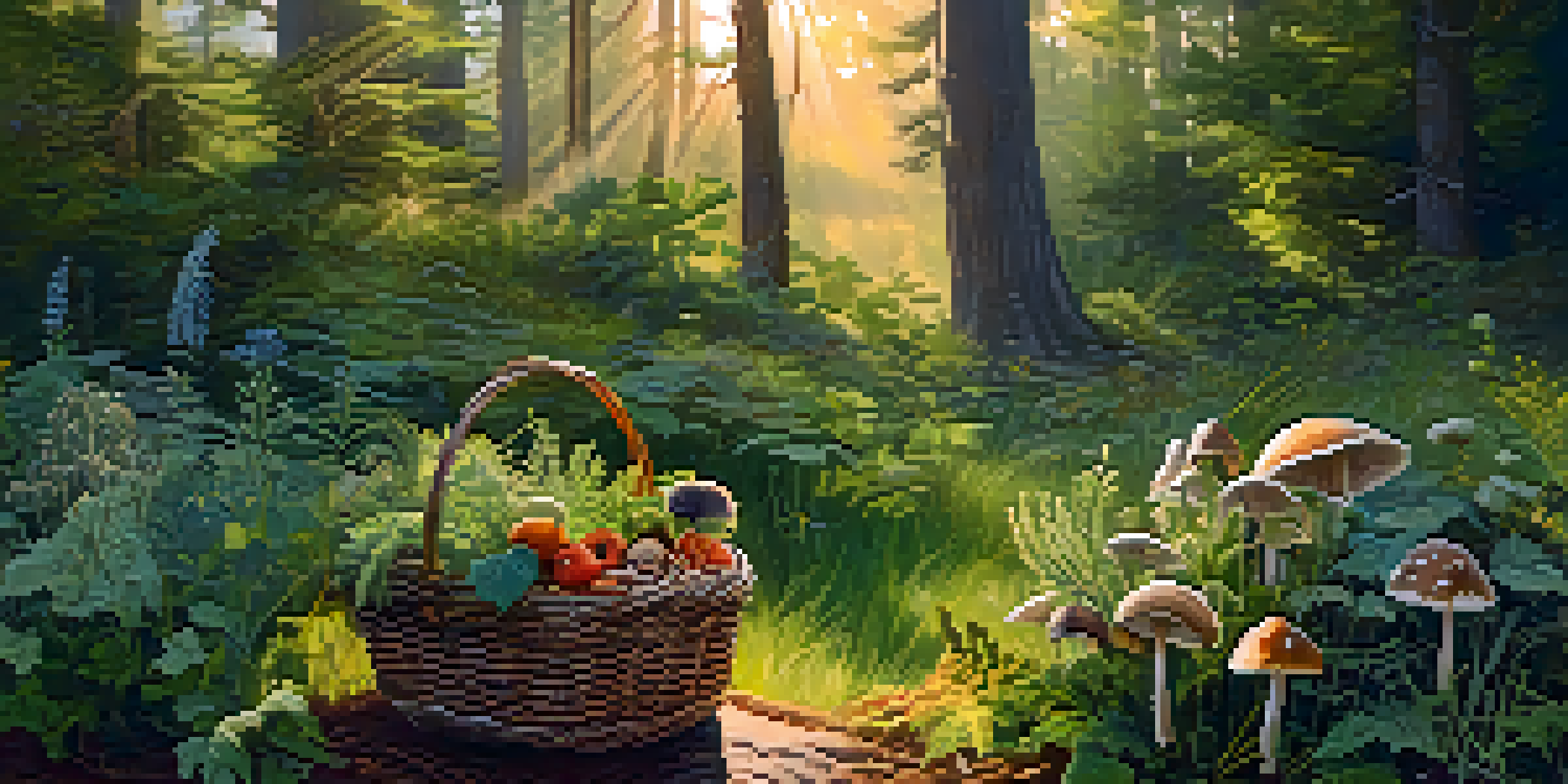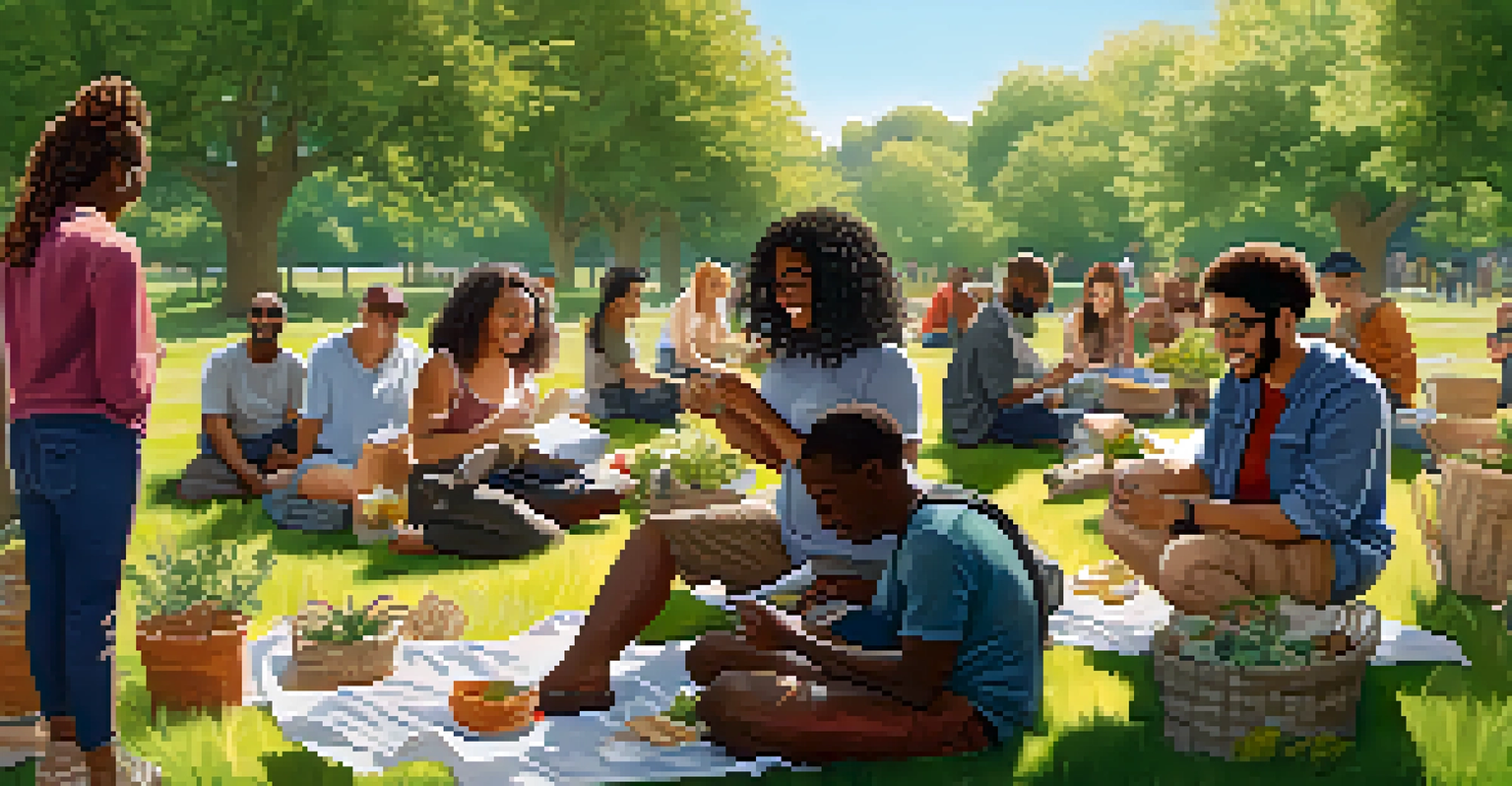How to Forage Responsibly: Leave No Trace Principles

Understanding Foraging and Its Importance
Foraging is the practice of collecting wild food resources from nature. It connects us with the environment and allows us to appreciate the abundance around us. However, responsible foraging is crucial to ensure that we preserve these resources for future generations.
In every walk with nature one receives far more than he seeks.
When you forage sustainably, you are not just gathering food; you are participating in a larger conversation about conservation. This practice encourages respect for nature and supports biodiversity by allowing plants and wildlife to thrive. In essence, responsible foraging is a way to enjoy nature while protecting it.
By understanding the importance of foraging, you can become more mindful of the impact your actions have on ecosystems. This awareness sets the stage for embracing the Leave No Trace principles, which guide us in our interactions with nature, ensuring we leave the environment as we found it.
The Leave No Trace Principles Explained
Leave No Trace is a set of seven principles designed to help outdoor enthusiasts minimize their impact on the environment. These principles provide a framework for responsible recreation, ensuring that natural areas remain pristine. They encompass everything from planning your trip to respecting wildlife and minimizing waste.

The principles include: Plan Ahead and Prepare, Travel and Camp on Durable Surfaces, Dispose of Waste Properly, Leave What You Find, Minimize Campfire Impact, Respect Wildlife, and Be Considerate of Other Visitors. By following these guidelines, you can enjoy foraging while protecting the delicate balance of nature.
Foraging Connects Us to Nature
Responsible foraging fosters a deeper appreciation for the environment and supports conservation efforts.
Understanding these principles is the first step in becoming a responsible forager. They remind us to think critically about our actions and their consequences, fostering a deeper connection with the land we explore.
Planning Your Foraging Adventure
Before you head out to forage, it's essential to plan your adventure carefully. Research local regulations and guidelines for foraging in your area, as some places may have restrictions on what can be harvested. Always check for any seasonal changes or endangered species that you should avoid.
Take only memories, leave only footprints.
Additionally, consider the time of year and the best locations for finding the plants or mushrooms you seek. Proper planning not only enhances your chances of success but also ensures you are foraging in a sustainable manner. By knowing where and when to go, you can minimize your impact on the environment.
Furthermore, pack essential tools and supplies to make your foraging experience enjoyable and efficient. A small basket for collection, a field guide for identification, and a first aid kit are just a few items to consider. Being prepared helps you stay safe while respecting the land you’re exploring.
Identifying Edible Plants and Fungi
One of the most critical aspects of foraging is being able to identify what is safe to eat. Misidentifying plants or fungi can lead to serious health risks, so investing time in learning about local species is essential. Field guides, apps, and foraging workshops can be invaluable resources for honing your identification skills.
When foraging, focus on learning a few key species well instead of trying to memorize everything. This approach not only boosts your confidence but also helps you recognize edible plants quickly. Remember, some plants may look similar, and understanding their differences is crucial for your safety.
Follow Leave No Trace Principles
Adhering to Leave No Trace guidelines helps minimize our impact on natural areas while enjoying outdoor activities.
Moreover, consider joining a local foraging group or finding a mentor. Learning from experienced foragers can provide practical knowledge and tips that books alone might not cover. Plus, foraging with others fosters a sense of community and shared responsibility for the environment.
Harvesting Responsibly and Sustainably
When it comes to harvesting, the mantra should always be 'take only what you need.' This means foraging in moderation and ensuring that you leave enough of a plant or mushroom for it to continue to thrive. A good rule of thumb is to take no more than 10% of any single species you encounter.
Additionally, use careful techniques to minimize damage to the plant and its surrounding ecosystem. For example, when harvesting greens, snip leaves rather than uprooting the entire plant, allowing it to regrow in the future. This approach not only promotes sustainability but also encourages biodiversity.
It's also essential to be mindful of the environment around you. Avoid trampling on delicate vegetation or disturbing wildlife habitats while foraging. By doing so, you help maintain the balance of the ecosystem and ensure that nature can continue to provide for future foragers.
Disposing of Waste Properly While Foraging
Proper waste disposal is a fundamental aspect of the Leave No Trace principles. When foraging, always carry out everything you bring in, including food wrappers, tools, and personal items. Leaving behind trash can harm wildlife and disrupt local ecosystems, so be diligent about keeping your environment clean.
In addition, consider composting any organic waste you generate during your foraging adventure. This practice not only reduces your impact but also enriches the soil if done appropriately. If you're in a public space, look for designated waste disposal areas or take your compostable waste home with you.
Community Enhances Foraging Experience
Engaging with fellow foragers promotes knowledge sharing and encourages sustainable practices in foraging.
By being responsible with your waste, you contribute to the preservation of natural spaces. This simple act reflects a commitment to the environment and demonstrates respect for the ecosystems you enjoy while foraging.
Respecting Wildlife During Your Foraging Journey
Respecting wildlife is crucial when foraging, as many species rely on the same plants and habitats you do. Always observe animals from a distance and avoid disrupting their natural behaviors. Remember, you are a guest in their home, so treat it with care and consideration.
Furthermore, refrain from harvesting plants that are critical for local wildlife, such as those that provide food or shelter. Understanding the role of each species in the ecosystem helps you make informed decisions about what to forage and what to leave untouched. This awareness fosters a sense of stewardship towards nature.

In addition, be mindful of the seasons and migratory patterns of wildlife. Avoid foraging during breeding seasons or times when animals are particularly vulnerable. By considering the needs of wildlife, you contribute to the health of the ecosystem and ensure that foraging can continue sustainably.
Embracing Community and Sharing Knowledge
One of the most rewarding aspects of foraging is the sense of community it fosters. Sharing your experiences and knowledge with others can inspire more people to engage in responsible foraging. Whether through local workshops, social media, or community gatherings, connecting with fellow foragers enriches the experience.
Consider creating a foraging group or participating in local events to share tips and techniques. This collaboration not only enhances your understanding but also promotes a culture of respect for nature. Together, you can learn how to forage responsibly and advocate for sustainable practices.
Lastly, encourage others to embrace the Leave No Trace principles in their foraging adventures. By spreading awareness and fostering a sense of responsibility, you help protect the very ecosystems that provide us with nourishment. Ultimately, a connected community of foragers can create lasting positive change in our relationship with nature.